The "Major Scale" or Ionian scale is a diatonic scale, made up of seven distinct notes, plus an eighth which duplicates the first one octave higher. In solfege these notes correspond to the syllables Do, Re, Mi, Fa, Sol, La, Ti/Si, (Do), the Do in the parenthesis at the end being the octave of the root.
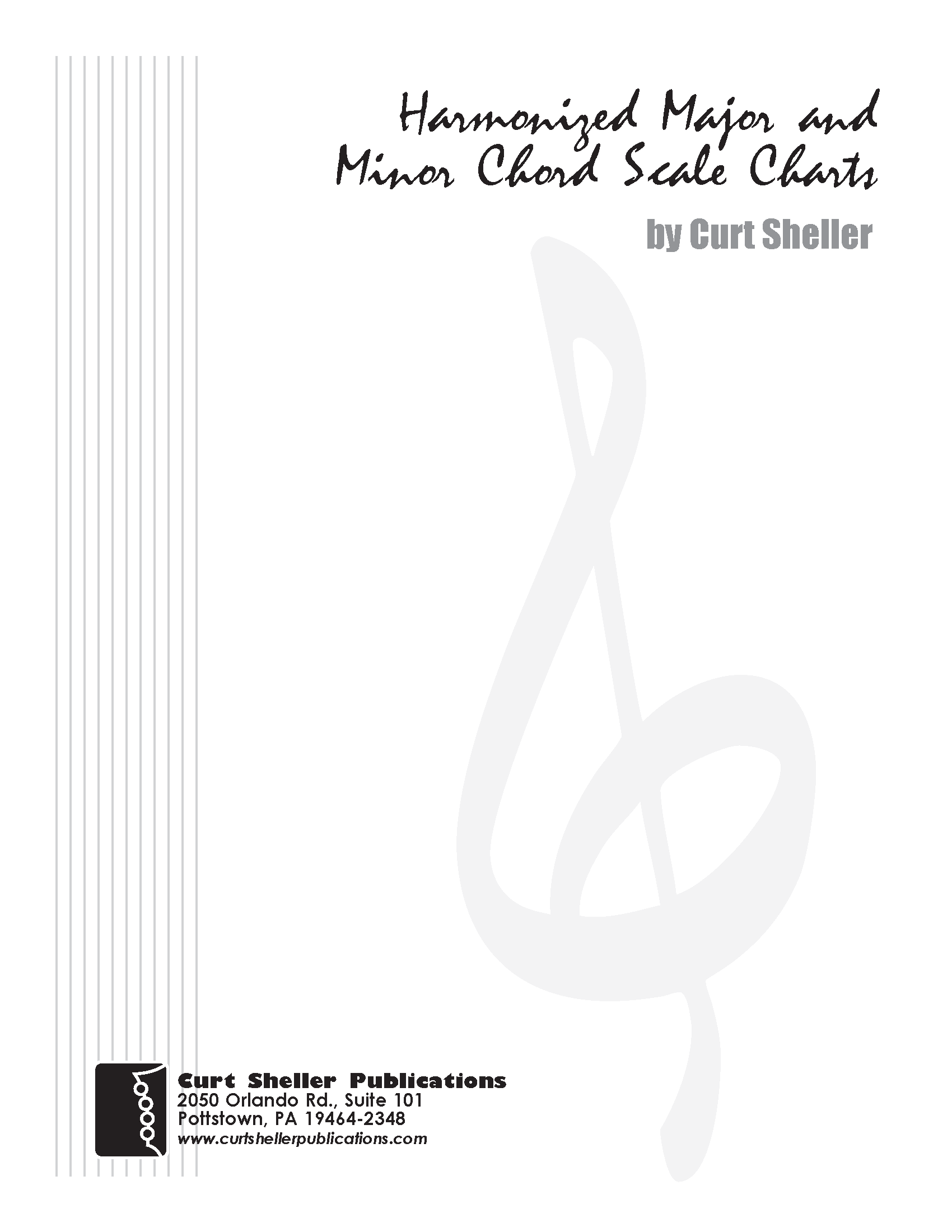
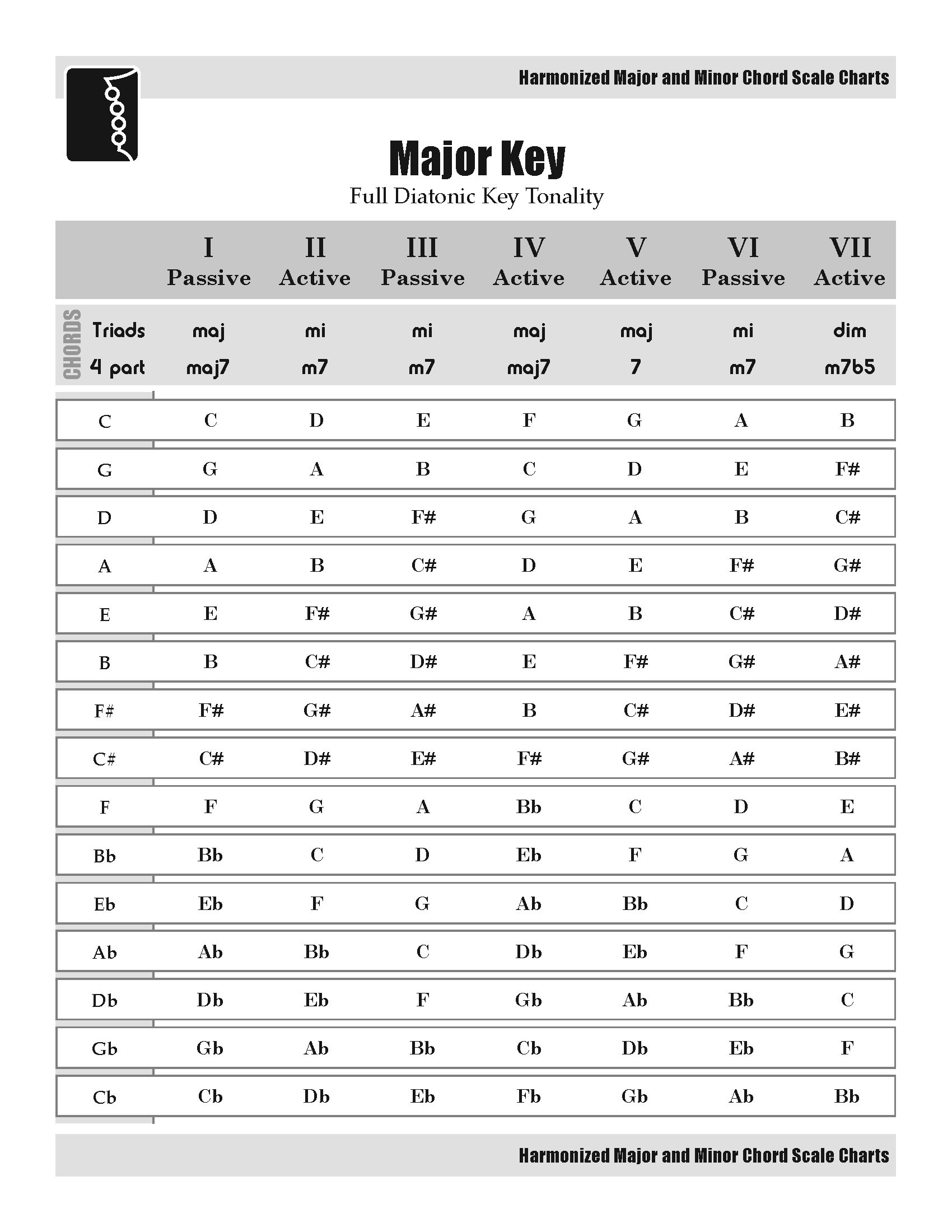

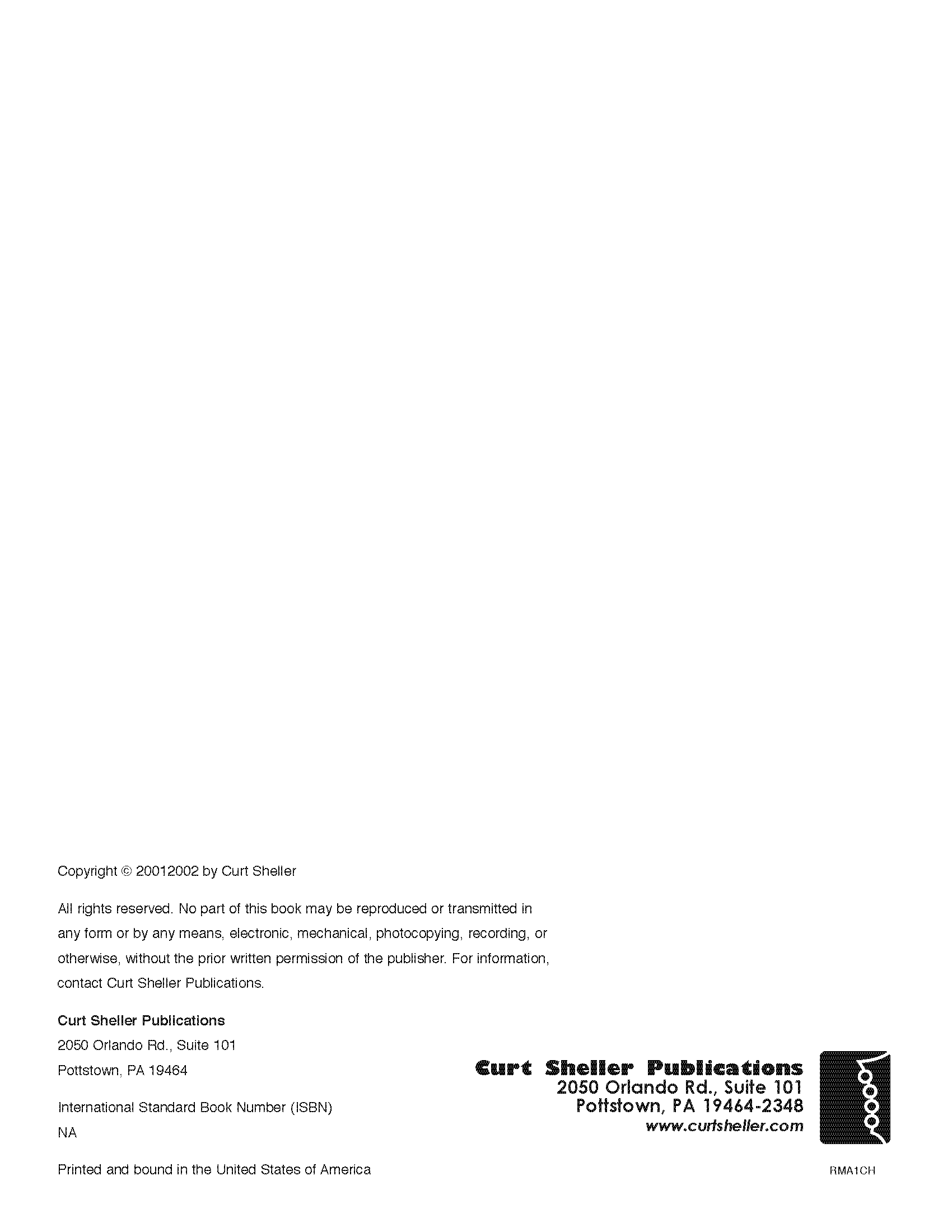




The Major Scale or Ionian scale is a diatonic scale, made up of seven distinct notes, plus an eighth which duplicates the first one octave higher. In solfege these notes correspond to the syllables “Do, Re, Mi, Fa, Sol, La, Ti/Si, (Do)”, the “Do” in the parenthesis at the end being the octave of the root.
The simplest major scale to write or play on the piano is C major, the only major scale that does not require sharps or flats. The C major scale uses only the white keys on the piano keyboard.
Available for Premium Site Access Plans Only
Major Scales
A major scale can be seen as two identical tetrachords separated by a whole tone, or whole step. A tetrachord is a series of three intervals filling in the interval of a perfect fourth separated by a whole tone, or whole step. Or a set of steps Whole, Whole, Half, Whole, Whole, Whole, Half. Each tetrachord consists of two whole steps followed by a half step. Western scales do not skip any line or space on the staff, and they do not repeat any note with a different accidental. This has the effect of forcing the key signature to feature just sharps or just flats.
Any major scale can be figured out using this step sequence.

Or as the number of steps between each note of the scale:
2 2 1 2 2 2 1
C Major is: C W D W E H F W G W A W B H C’
The C Major Scale
C D E F G A B C' - The white keys of a piano.

Each note of a major scale can be numbered relative to its distance or number of steps from the tonic or One, the first note of the scale.

These numbers are also referred to as scale degrees. D is the second, E the third, F the fourth, G the fifth, A the sixth, B the seventh and finally, C again at the octave.
They also have the familiar solfège names used to teach pitch and sight singing - basically vocal training.
- Do
- Re
- Mi
- Fa
- So
- La
- Si or Ti
C Major Scale Uses
Ear Training - Using familiar songs you can train your ear to recognize common intervals.
Using a fixed Do and ascending intervals here are some common songs you can use.
- Do to Do - C to C, Perfect Unison [ Happy Birthday to You ]
This one should be easy as the note does not change. If you really have a hard time hearing this one you might consider a different hobby or career.
- Do, Re - C to D, Major Second [ Frère Jacques)
- Do, Mi - C to E, Major Third [ Michael Row Your Boat Ashore, Kumbaya, Do-Re-Mi (first and third notes) ]
- Do, Fa - C to F, Perfect Fourth [ Here Comes the Bride, Amazing Grace, Smells Like Teen Spirit, The Look of Love ]
- Do, Sol - C to G, Perfect Fifth [ Twinkle Twinkle Little Star, My Favorite Things, Georgie Girl, Scarborough Fair, Theme from Star Wars ]
- Do, La - C to A, Major Sixth [ My Bonnie Lies over the Ocean, NBC Theme Song, Take the 'A' Train ]
- Do, Si - C to B, Major Seventh [ Theme from Fantasy Island ]
- Do to Do - C to C, Perfect Octave [ Over the Rainbow, Hi Ho Hi Ho, The Christmas Song, Let It Snow ]
Here is a related lesson and with more information on Ear Training .
C Major Scale Chords
The chords for a C major scale are:
- Triads: C Dm Em F G Am Bdim
- 4-part “jazz” Chords: Cmaj7 Dm7 Em7 Fmaj7 G7 Am7 Bm7b5
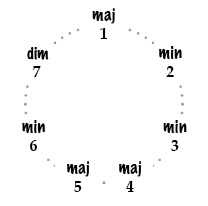
The sequence of major, minor, minor, major, major, minor, diminished. Is the same sequence for ALL the major keys. And, by starting the sequence at a different spot it's also the same chords for the scale modes: Dorian, Phrygian, Lydian, Mixolydian, Aeolian, Locrian, and Ionian.
You can get a lot out of this sequence.
C Major Scale as Your Reference Scale
From the C major scale you can get the other major scales and their modes, major, relative minor and modes key signatures and the chords of the same.
Just memorize the key signature of the major keys and substitute place the sharp or flats in the circle of notes. Use a chart or the major scale step pattern: W W H W W W H, to figure out the scale.
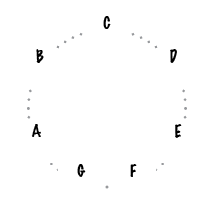
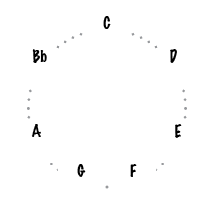
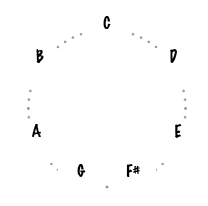
From the Major scales you can get the Traditional Scales: Natural Minor, Minor, Harmonic Minor, Melodic Minor, Tonic Minor, Diminished and Whole Tone.
Scale Modes: Ionian, Dorian, Phrygian, Lydian, Mixolydian, Aeolian, Locrian
Contemporary Scales: Blues, Minor Pentatonic and Major Pentatonic
Altered Scales: Mixolydian +4, Mixolydian -2-6
Some scales are know by different names. Mixolydian is the Dominant scale. The Mixolydian +4 is the Lydian Dominant. Lots of names for the same scales.
The Major Scale or Ionian scale is a diatonic scale, made up of seven distinct notes, plus an eighth which duplicates the first one octave higher. In solfege these notes correspond to the syllables “Do, Re, Mi, Fa, Sol, La, Ti/Si, (Do)”, the “Do” in the parenthesis at the end being the octave of the root.
The simplest major scale to write or play on the piano is C major, the only major scale that does not require sharps or flats. The C major scale uses only the white keys on the piano keyboard.
Available for Premium Site Access Plans Only
Major Scales
A major scale can be seen as two identical tetrachords separated by a whole tone, or whole step. A tetrachord is a series of three intervals filling in the interval of a perfect fourth separated by a whole tone, or whole step. Or a set of steps Whole, Whole, Half, Whole, Whole, Whole, Half. Each tetrachord consists of two whole steps followed by a half step. Western scales do not skip any line or space on the staff, and they do not repeat any note with a different accidental. This has the effect of forcing the key signature to feature just sharps or just flats.
Any major scale can be figured out using this step sequence.

Or as the number of steps between each note of the scale:
2 2 1 2 2 2 1
C Major is: C W D W E H F W G W A W B H C’
The C Major Scale
C D E F G A B C' - The white keys of a piano.

Each note of a major scale can be numbered relative to its distance or number of steps from the tonic or One, the first note of the scale.

These numbers are also referred to as scale degrees. D is the second, E the third, F the fourth, G the fifth, A the sixth, B the seventh and finally, C again at the octave.
They also have the familiar solfège names used to teach pitch and sight singing - basically vocal training.
- Do
- Re
- Mi
- Fa
- So
- La
- Si or Ti
C Major Scale Uses
Ear Training - Using familiar songs you can train your ear to recognize common intervals.
Using a fixed Do and ascending intervals here are some common songs you can use.
- Do to Do - C to C, Perfect Unison [ Happy Birthday to You ]
This one should be easy as the note does not change. If you really have a hard time hearing this one you might consider a different hobby or career.
- Do, Re - C to D, Major Second [ Frère Jacques)
- Do, Mi - C to E, Major Third [ Michael Row Your Boat Ashore, Kumbaya, Do-Re-Mi (first and third notes) ]
- Do, Fa - C to F, Perfect Fourth [ Here Comes the Bride, Amazing Grace, Smells Like Teen Spirit, The Look of Love ]
- Do, Sol - C to G, Perfect Fifth [ Twinkle Twinkle Little Star, My Favorite Things, Georgie Girl, Scarborough Fair, Theme from Star Wars ]
- Do, La - C to A, Major Sixth [ My Bonnie Lies over the Ocean, NBC Theme Song, Take the 'A' Train ]
- Do, Si - C to B, Major Seventh [ Theme from Fantasy Island ]
- Do to Do - C to C, Perfect Octave [ Over the Rainbow, Hi Ho Hi Ho, The Christmas Song, Let It Snow ]
Here is a related lesson and with more information on Ear Training .
C Major Scale Chords
The chords for a C major scale are:
- Triads: C Dm Em F G Am Bdim
- 4-part “jazz” Chords: Cmaj7 Dm7 Em7 Fmaj7 G7 Am7 Bm7b5

The sequence of major, minor, minor, major, major, minor, diminished. Is the same sequence for ALL the major keys. And, by starting the sequence at a different spot it's also the same chords for the scale modes: Dorian, Phrygian, Lydian, Mixolydian, Aeolian, Locrian, and Ionian.
You can get a lot out of this sequence.
C Major Scale as Your Reference Scale
From the C major scale you can get the other major scales and their modes, major, relative minor and modes key signatures and the chords of the same.
Just memorize the key signature of the major keys and substitute place the sharp or flats in the circle of notes. Use a chart or the major scale step pattern: W W H W W W H, to figure out the scale.



From the Major scales you can get the Traditional Scales: Natural Minor, Minor, Harmonic Minor, Melodic Minor, Tonic Minor, Diminished and Whole Tone.
Scale Modes: Ionian, Dorian, Phrygian, Lydian, Mixolydian, Aeolian, Locrian
Contemporary Scales: Blues, Minor Pentatonic and Major Pentatonic
Altered Scales: Mixolydian +4, Mixolydian -2-6
Some scales are know by different names. Mixolydian is the Dominant scale. The Mixolydian +4 is the Lydian Dominant. Lots of names for the same scales.
Related Lessons, Videos, Lesson Series, Songs, Books & Reference Charts, Resources & Assets, Workshops are below.

Traditionally, a tetrachord is a series of four tones filling in the interval of a perfect fourth. In modern usage a tetrachord is any four-note segment of a scale or tone row including the augmented fourth (+4). The term tetrachord derives from ancient Greek music theory, it literally means four strings.

The Ionian scale is a major scale more commonly known by its traditional name - Major and one of six essential scales for ALL ukulele players. One octave scale fingering solutions for strings four and three and any finger with the Mixolydian scale chords are covered in all keys. Sample chord progressions for practice are included. Tunings: C with low or high G - (GCEA or gCEA). This book includes access to four studio recorded backing tracks for exploring the scale and improvisation in a variety of settings. Tracks are also great for practicing your chords against.

Daily Practice Material for the Contemporary Ukulele Player is an organized collection of daily practice and reference material for the contemporary ukulele player. This material can be used to develop the vocabulary and knowledge necessary for single note playing.


return in your investment)—it is this— learning the
f*ckingnotes of your OWN instrument. Sorry for the tough talks—but it is sooooo true!


Learn to read single note melodies in the first/open position is a lot easier than you might think. Book: Ukulele – Reading Music Series – Primer

An organized collection of daily practice and reference material for the contemporary ukulele player for developing the vocabulary and knowledge necessary for single note playing. Book: Daily Practice Material for the Contemporary Ukulele
Checkout the Books & Reference Charts for additional Handy, Dandy Reference Charts.

Ukulele Fingerboard Chart for C Tuning, Low or High G – G C E A

Ukulele Fingerboard Chart for G Tuning, Low or High A – D G B E

A handy reference chart of all 15 major and relative minor key signatures. US Letter 8.5 x 11 sized (ANSI-A) , A4



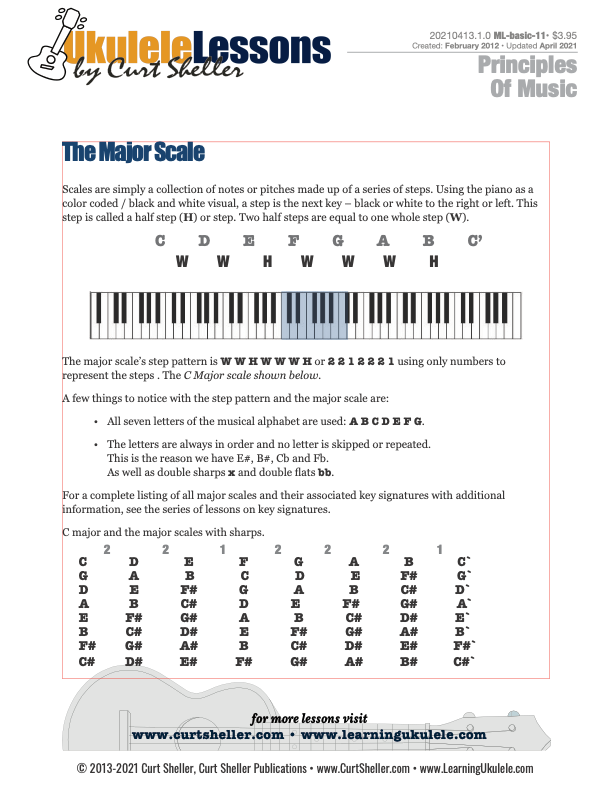





.jpg)